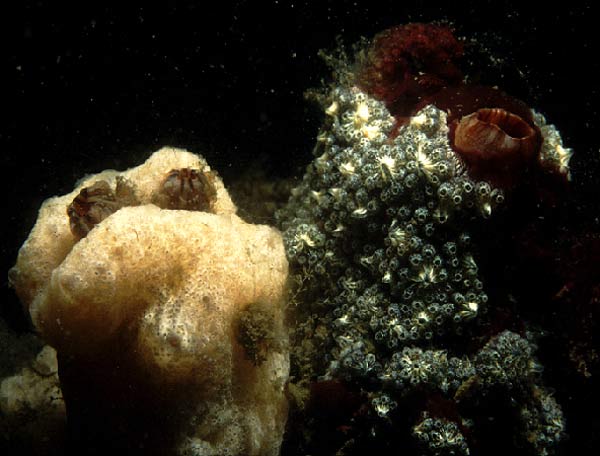- Botryllus schlosseri
Taxobox
name = Botryllus schlosseri
image_caption=Tunicate colonies of "Didemnum sp." (left) and "Botryllus schlosseri" (right) overgrowing individuals of the tunicate "Styela clava ".
regnum =Animal ia
phylum = Chordata
subphylum =Urochordata
classis =Ascidiacea
ordo =Pleurogona
suborder =Stolidobranchia
familia =Botryllidae
genus = "Botryllus"
species = "B. schlosseri"
binomial = "Botryllus schlosseri"
synonyms = "Alcyonium schlosseri"Cite web|url=http://species.wikimedia.org/wiki/Botryllidae|title=Botryllidae-Wikispecies|accessdate=2007-02-17]
binomial_authority = (Pallas, 1766)"Botryllus schlosseri", commonly known as the golden star tunicate, is an invasive, colonial ascidian
tunicate that grows on slow-moving, submerged objects, plants, and animals in nearshore saltwater environments.Its range has spread over the last 100 years to a nearly worldwide extent. Ranging in the western
Atlantic ocean from theBay of Fundy toNorth Carolina , this is "the most common colonial tunicate in North America."Cite web|url=http://books.google.com/books?vid=ISBN1881652327&id=dq-iIBVn4_MC&dq=spiral+tufted+bryozoa|title=Marine Life of the North Atlantic: Canada to New England |accessdate=2007-02-17|publisher=Aqua Quest Publications|year=2003|author=Andrew J. Martinez] This species can be distinguished from "Botrylloides sp." by the pattern of growth. "B. schlosseri" zooids emanate from a center in the manner of the arms of a star. Also, there usually are fewer zooids per cluster (5-8 in "B. schlosseri" and 10 or more in "Botrylloides").External links
* http://ip30.eti.uva.nl/bis/tunicata.php?selected=beschrijving&menuentry=soorten&id=21
Notes
Wikimedia Foundation. 2010.
